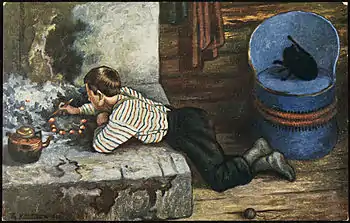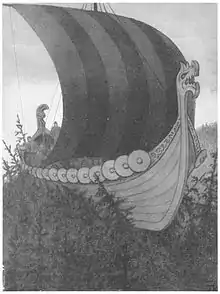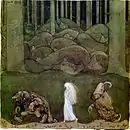Askeladden
Ashlad (Norwegian "Askeladden", full name "Esben Askelad" or "Espen Askeladd") is a main character in a number of tales collected in Asbjørnsen and Moe's Norwegian Folktales.

The character starts out being regarded as an incapable underachiever, but eventually proves himself by overcoming some prodigious deed, succeeding where all others have failed.
The character's name appeared as Boots in Dasent's 19th century English translations.
Name
The name Askeladden (meaning 'ash-lad'[1]) or Askeladd[2] is the standard form which Asbjørnsen and Moe eventually settled for. However, the storytellers used this[lower-alpha 1] alongside other variant names such as Askefis, sometimes interchangeably within the same tale.[lower-alpha 2][3]
In fact, the most frequently recorded original name was Oskefisen or Askefis,[4][5] glossed as a person who blows on the coal to stoke the fire.[6][7][lower-alpha 3] The latter word is attested since the 15th century, in proverbs.[6][8] This would make sense, as the job of blowing on the embers was often assigned to the person of the household who was considered the least fit for other, more demanding chores – typically a fragile grandmother or a small child.
But because the editors felt Askefis to be too rustic, they favoured the name Askeladden (or altered it to Askepot) which seemed more refined. This adulteration was derided by P. A. Munch as overly prim and lacking courage.[3] In Asbjørnsens's first edition (1843), the name appears as Askepot,[9] which in Norway is commonly associated with Cinderella. The name was changed to Askeladden in the second edition, [10] but strangely enough, in the first tale ("About Askeladden who Stole from the Troll"), the name Askepot was still retained in the narrative itself.[10][3]
The form Esben Askepot[11] was later changed to Esben Askelad in the second edition by Asbjørnsen and Moe,[12] then later to Espen Askeladd by Moltke Moe[13][lower-alpha 4]
Etymology
Askelad or Askeladd (without the definite -en suffix[14]) are Danized, or Dano-Norwegian forms.[15][16] The Norwegian form Oske-ladd is composed of oske 'ash' and ladd 'hair sock' (related to loden 'hairy, shaggy'),[lower-alpha 5] with the explanation that ashes allowed to cling to the feet seem like furry socks.[18]
A more conjectural etymology hypothesizes the second part to be related to lodden meaning "blow gently", which conforms with the idea behind the name Askefis, of a person who blows on the embers to enliven the fire.[19]
As for Esben Oskelad, Esben is said to be a variant of Esbern, cognate to the Norse name Asbjørn and English name Osborn.[20]
English translations
Askeladd/Oskeladd has been rendered into English as "Cinderlad" (or "Ash-Lad"), this fails to accurately reflect the meaning as outlined above.[21]
George Webbe Dasent chose to translate the name (Askefis, Askepot) as "Boots",[22] which was criticized as a "disenchanting rendering" of "Cinderson" by The Athenaeum literary magazine,[23] but defended as "aptly styled" by Scottish folklorist W. A. Clouston.[24] Dasent was well aware of cognate names in Scots English dialects, such as "Ashiepattle" and "Ashypet".[22] Dasent says he coined the name "Boots" as representative of the tradition in English households that the youngster of the family were expected to perform the meanest chores.[22] He fails to elaborate more than this, but "boots" is glossed as "the servant at an inn who pulls off and cleans the boots of travellers" in a dictionary from the Victorian Era.[25]
General description
Askeladden is characterised as the runt of the family, being "the youngest, smallest, and weakest",[1] yet "clever, bold, patient", and against all odds, eventually successful.[1] The hero has great rewards in store, often the princess's hand in marriage and half the kingdom.[4]
However, as Jan Brunvald has noted, there is somewhat of a gap between the Askeladden in the actual folktales, and the national hero and symbol of every countryman (Norwegian: landsmann) to which he has been elevated by the Norwegian populace.[26][27]
In the folktales, by all accounts, Askeladden remains near the hearth and idly "roots about",[28] but according to Norwegian sources, he is forced by his family to sit in the ashes in the hearth.[4][29]
The character is also closely related to the common and quite nationalistic jokes of the three Scandinavian archetypes, the Norwegian, the Swede and the Dane. In those jokes, the Norwegian always succeeds in petty contests where the others do not. The jokes resemble the fairy-tale pattern and are mostly told by Norwegian children. Here, one can interpret the Norwegian as the youngest and underdog brother of the three, a parallel to the historical facts of Norway's position in Scandinavia.
List of folktales
Askeladden is the protagonist in numerous folk tales:
- Spurningen (NF #4);[33]
- "The Quandary".[34][lower-alpha 6]
- Prinsessen som ingen kunne målbinde (NF #4 var.);[lower-alpha 7][36][37]
- "The Princess who always had to have the Last Word".[38]
- "Nothing is Needed by the One That All Women Love".[34]
- "The Golden Castle that Hung in the Air"[56][lower-alpha 8]
- "Osborn Boots and Mr. Glibtongue"[59]
- "The Ash Lad and the Good Helpers"[62][lower-alpha 9]
Survey of folktales

In many folk tales, the Ash Lad is portrayed as the youngest of three brothers. Early in a typical tale, the older brothers appear to have much greater chances of success in life. For example, one brother might be extremely well read, whereas another might be extremely competent in another area. In contrast, the Ash Lad is looked down upon as a seemingly drowsy ne'er do well, perhaps even as a loner or misunderstood eccentric, who spends too much time sitting by the fireplace lost in thought as he is poking the ashes.
As the typical story unfolds, the oldest brothers try first to heroically overcome some major crisis or problem. As an example, one tale involves rescuing a princess held captive in a land East of the Sun and West of the Moon (akin to the homonymous fairy tale). The two older brothers, who are tied to conventional thinking, typically fall flat on their faces. In contrast, it is the Ash Lad who comes up with creative solutions. He is smarter, more tactical, more receptive and more aware of the needs of others. He outwits trolls, dodges charging unicorns or gets a magic Viking ship to transport him (similar to an also-popular folk tale, "The Fool and the Flying Ship") where he ultimately saves the princess.
The "heroic" trait of the character is probably most prominent in the stories told by Peter Christen Asbjørnsen and Jørgen Moe. The tales they collected present the "classical" Ash Lad. In other stories, collected by others, the character and his brothers are presented as mere scoundrels, even thieves. Those stories present the youngest brother as the one with the wits about him, and thus, he gets away with the loot. They always steal from the wealthy farmers or even the king, similar to the fabled Robin Hood. Those stories are documented from Vest-Agder, in their time the poorest parts of Norway, where suppression was common. Thus, the Ash Lad has some similarities with the Norwegian crime writer Gjest Baardsen (1791–1849).
Further analysis
The origin of the Askeladden character has been sought by some scholars in the old Norse god Loki, in his aspect as a fire vættir.[66]
Parallels
In the "Peer and Paul and Esben Askelad" the father does not own even the shirt on his back, and tells his sons to make their fortune in the world. There is a variant collected by the NFS (Norsk Folkeminnesamling) where the father says he only has ragged skin trousers for clothes to provide, and sends out his sons to the world. To this has been found an Irish counterpart "Adventures of Gilla na Chreck an Gour" (recté "Adventure of [an] Giolla an Chroicinn Gabhair" or 'The Fellow with the Goat-skin'[67][68]), which is an ash-lad tale in which the woman provides the boy kept around the hearth with a goat-skin to wrap around the waist.
Derivative literature
It has been observed that Henrik Ibsen's play Peer Gynt draws from Norwegian folklore, with some portions in particular owing to Askeladden tales. Albert Morey Sturtevant argued that Ibsen's almost proverbial phrase,
Den tør være nyttig til mange til ting |
It may be useful for many a thing |
| —Ibsen | —Sturtevant tr. |
which express the notion that one may never know the usefulness of seemingly trifling things until it is tested, derived from Per, Pål og Espen Askeladd (where Esben and Espen Askeladd are equivalent).[35][lower-alpha 10] But Henri Logeman contested the choice of tale, and instead favored Spurningen, for in that story Askeladden not merely finds trifling things, but his finds included a dead magpie, like Ibsen's verse (A variant of Spurningen was published later, entitled Prinsessen som ingen kunne målbinde, and is also an alternative strong candidate).[lower-alpha 11][2]
Explanatory notes
- With variant spelling "Aaskeladen"
- "A folklore collector noticed that one informant began a tale with the name 'Aaskefis'n' but later on called him 'Aaskeladden'"; "another storyteller used Askeladden for the name throughout but commented, 'We used to call him Aaskefisen.' Brunvald, citing NFS, Langset VI, field notes.
- Or, by Jørgen Moe, explained as "he who blows in the grate to get the fire up".[3]
- The tale, " "Peer and Paul and Esben Askelad" in the second edition was No. 50;[12] changed to Espen Askeladd and no. 49 in later editions (1904).[13]
- And further related to Old Norse loðinn and the byname of Ragnarr Loðbrók, "Shaggy Breeches".[17]
- Translated as "Taming the Shrew" by Dasent (1859).
- A "slight variant" of Spurningen.[35]
- Dasent: "The Golden Palace That Hung in the Air"
- Dasent:"Boots and his Crew"
- NF 49 listed above.
- NF 4 Spurningen listed above, and Prinsessen som ingen kunne målbinde from the Eventyrbog for Børn ("Folktale-book for a child").
References
- Citations;
- Brunvand (1959), p. 14.
- Logeman, Henri (June 1914), "Another Three Notes on 'Peer Gynt'", Publications of the Society for the Advancement of Scandinavian Study, 1 (5): 215, JSTOR 40914922
- Brunvand (1959), p. 15.
- "Askeladden". Store norske leksikon. Snl.no. Retrieved 2013-12-29.
- Brunvand (1959), p. 15: "Askefisen.. was most often encountered".
- "Askefis". Store norske leksikon. Snl.no. Retrieved 2013-12-29.
- Langemo (1960), p. 259: "signifies one who blows at the coals to make the fire blaze".
- Langemo (1960), p. 259.
- Asbjørnsen, Peter Christen; Moe, Jørgen, eds. (1843). 1. Om Askepot, som stjal Troldets Sølvænder, Sengetæppe og Guldharpe. Norske folke-eventyr. 1ste Deel (1 ed.). Christiania: Johan Dahl. pp. 1–7.
- Asbjørnsen, Peter Christen; Moe, Jørgen, eds. (1852). 1. Om Askeladden, som stjal Troldets Sølvænder, Sengetæppe og Guldharpe. Norske folke-eventyr (2 ed.). Christiania: Johan Dahls Forlag. pp. 1–6.
- Asbjørnsen, Peter Christen; Moe, Jørgen, eds. (1844). 50. Peer og Paul og Esben Askepot. Norske folke-eventyr. 2nden Deel (1 ed.). Christiania: Johan Dahl. pp. 67–73.
- Asbjørnsen & Moe (1852) (2d ed.), "50. Peer og Paul og Esben Askelad" pp. 306–311.
- Asbjørnsen, Moe & Moe (1904) (7th ed.) "49. (2-15.) Per og Paal og Espen Askeladd", 2: 110–116.
- Bergdal (1929), p. 168: "the final -en has universally been regarded as merely the suffixed article, which it probably is".
- Bergdal (1929), p. 167, citing Brynildsen, John (1902) "Boots": "Askeladden, Esben Askelad, i Eventyret", A Dictionary of the English and Dano-Norwegian Languages, p. 107
- Bergdal (1929), p. 167, citing Brynildsen, John (1927) "Aske-ladd": "a child allowed to lie among the ashes, neglected child", Norsk-engelsk ordbok, p. 33
- Bergdal (1929), p. 171.
- Bergdal (1929), pp. 167–168.
- Bergdal (1929), p. 172.
- Bergdal (1929), p. 167.
- Bergdal (1929), p. 168.
- Dasent (1859), p. cliii.
- Anon. (20 June 1896), "George W. Dasent", Athanaeum (3582): 811–812
- Clouston, W. A. (1890), "The Story of 'The Frog Prince': Breton variant, and some analogues", Folk-lore, 1: 506
- Sullivan, Robert (1847). Dictionary of the English Language: With a Vocabulary of Scripture Proper Names, and a Concise Classical Dictionary. Dublin: Alex. Thom. p. 30.
- Brunvand (1959).
- Christiansen, Reidar Thoralf (2016) [1964]. Folktales of Norway. Translated by Pat Shaw Iversen. University of Chicago Press. p. x. ISBN 0-226-37520-X.
Brunvand distinguishes between the actual dusty Askeladden of the folktales and the glamorized hero
- Brunvand (1959), pp. 15–16.
- Brunvand (1959), pp. 16–17.
- Asbjørnsen, Moe & Moe (1904) (7th ed.) "1. Om Askeladden som stjal Troldets Sølvander, Sengetæppe, og Gulharpe", 1: 1–7.
- Asbjornsen and Moe. "Askeladden som stjal sølvendene til trollet". Norske Folkeeventyr – via Project Runeberg. (in Bokmål)
- Nunnally (2019). The Complete Tales are numerically ordered as in Norske Folkeeventyr
- Asbjørnsen, Moe & Moe (1904) (7th ed.) "4. Spurningen", 1: 22–23.
- Nunnally (2019).
- Sturtevant, Albert Morey (February 1912), "Three Notes on Ibsen's Peer Gynt", Publications of the Society for the Advancement of Scandinavian Study, 1 (2): 35–37, JSTOR 40914895
- Asbjørnsen&Moe (1883–1887) eds.,Eventyrbog 3: 1–29; "De tre kongsdøtre i berget det blaa" Eventyrbok 2nd ed. (1908) 3: 5–27;
- Asbjornsen and Moe. "Prinsessen som ingen kunne målbinde". Norske Folkeeventyr – via Project Runeberg. (in Bokmål)
- Shaw & Norman (1990), No. 22.
- Asbjørnsen, Moe & Moe (1904) (7th ed.) "6. Askeladden som kapaad med Troldet", 1: 39–41.
- Asbjornsen and Moe. "Askeladden som kappåt med trollet". Norske Folkeeventyr – via Project Runeberg. (in Bokmål)
- Asbjørnsen, Moe & Moe (1904) (7th ed.) "25. Dukken i Græsset", 1: 151–153.
- Asbjornsen and Moe. "Dukken i gresset". Norske Folkeeventyr – via Project Runeberg. (in Bokmål)
- Asbjørnsen, Moe & Moe (1904) (7th ed.) "31. De syv Folerne", 1: 183–192.
- Asbjornsen and Moe. "De syv folene". Norske Folkeeventyr – via Project Runeberg. (in Bokmål)
- Asbjørnsen, Moe & Moe (1904) (7th ed.) "36. (2-2.) Om Risen som ikke havde noe Hjerte paa seg", 2: 8–17.
- Asbjornsen and Moe. "Risen som ikke hadde noe hjerte på seg". Norske Folkeeventyr – via Project Runeberg. (in Bokmål)
- Asbjørnsen, Moe & Moe (1904) (7th ed.) "38. (2-4.) Det har ingen Nød med den som alle Kvindfolk er glad i", 2: 31–43.
- Asbjornsen and Moe. "Det har ingen nød med den som alle kvinnfolk er glad it". Norske Folkeeventyr – via Project Runeberg. (in Bokmål)
- Asbjørnsen, Moe & Moe (1904) (7th ed.) "39. (2-5.) Askeladden som fik Prinsessen til at løgste sig", 2: 44–45.
- Asbjornsen and Moe. "Askeladden som fikk prinsessen til å løgste seg". Norske Folkeeventyr – via Project Runeberg. (in Bokmål)
- Asbjornsen and Moe. "Per, Pål og Espen Askeladd". Norske Folkeeventyr – via Project Runeberg. (in Bokmål)
- Asbjørnsen, Moe & Moe (1904) (7th ed.) "51. (2-17.) Jomfruen paa Glassberget", 2: 122–132.
- Asbjornsen and Moe. "Jomfruen på glassberget". Norske Folkeeventyr – via Project Runeberg. (in Bokmål)
- Asbjørnsen & Moe (1871) Ny Samling " 72. Guldslottet som hang i Luften, pp. 65–73
- Asbjornsen and Moe. "Gullslottet som hang i luften". Norske Folkeeventyr – via Project Runeberg. (in Bokmål)
- Shaw & Norman (1990), No. 6.
- Asbjørnsen & Moe (1871) Ny Samling " 76. Rødræv og Askeladden, pp. 45–58
- Asbjornsen and Moe. "Rødrev og Askeladden". Norske Folkeeventyr – via Project Runeberg. (in Bokmål)
- Dasent (1874) "Osborn Boots and Mr. Glibtongue", pp. 246–257.
- Asbjørnsen & Moe (1871) Ny Samling " 79. Askeladden og de gode hjælperne, pp. 82–90
- Asbjornsen and Moe. "Askeladden og de gode hjelperne". Norske Folkeeventyr – via Project Runeberg. (in Bokmål)
- Shaw & Norman (1990), No. 8.
- Asbjørnsen & Moe (1871) Ny Samling " 98. Gjaerte Kongens Harer, pp. 199–197
- Asbjornsen and Moe. "Gjete kongens harer". Norske Folkeeventyr – via Project Runeberg. (in Bokmål)
- Stroebe & Martens (1922), No. 25 The King's Hares, pp. 202–212
- Heide, Eldar (2011), "Loki, the 'Vätte', and the Ash Lad: A Study Combining Old Scandinavian and Late Material", Viking and Medieval Scandinavia, 7: 63–106, JSTOR 45019150
- Kennedy, Patrick, ed. (1866), "Adventures of Gilla na Chreck an Gour", Legendary Fictions of the Irish Celts, London: Macmillan and Co., pp. 23–32 and note
- Lysaght, Patricia (2003), Davidson, Hilda Roderick Ellis; Chaudhri, Anna (eds.), "The Wonder Tale in Ireland", A Companion to the Fairy Tale, Dublin: Boydell & Brewer, p. 175, ISBN 0-859-91784-3
- Bibliography
- Asbjørnsen, Peter Christen; Moe, Jørgen; Moe, Moltke, eds. (1904). Norske folke-eventyr. 2 (7 ed.). Christiania: Forlagt af H. Aschehoug & Co.; Volume 2
- Asbjørnsen, Peter Christen; Moe, Jørgen, eds. (1871). Norske folke-eventyr: ny samling. Dybwad i Komm.
- Bergdal, Ed. (May 1929), "Hamlets Name", Scandinavian Studies and Notes, 10 (6): 159–175, JSTOR 40915272
- Brunvand, Jan (March 1959), "Norway's Askeladden, the Unpromising Hero, and Junior-Right", The Journal of American Folklore, 72 (283): 14–23, JSTOR 538383
- Dasent, G. W., tr., ed. (1859). Popular Tales from the Norse. Asbjørnsen and Moe (2nd, enlarged ed.). Edinburgh: Edmonston and Douglas.
- Dasent, G. W., tr., ed. (1874). Tales from the Fjeld: A Second Series of Popular Tales. Asbjørnsen and Moe (orig. edd.). Chapman & Hall.
- Langemo, Amanda (1960), "Askeladden", The American-Scandinavian Review, 48: 259–
- Nunnally, Tiina, tr., ed. (2019). The Complete and Original Norwegian Folktales of Asbjornsen & Moe. Minneapolis: University of Minnesota Press. ISBN 1-452-96455-6.
- Shaw, Pat; Norman, Carl, trs., eds. (1990) [1960]. Norwegian Folktales. Asbjørnsen and Moe (orig. edd.). Pantheon Books. pp. 17–18. ISBN 82-09-10598-1.
- Stroebe, Klara, tr., ed. (1922). Norwegian Fairy Book. Translated by Martens, Frederick H. Asbjornsen and Moe; George W. Hood (illus.). Frederick A. Stokes Company.; e-text via Internet Archive
External links
| Wikimedia Commons has media related to Askeladden. |
- Norwegian Legends & Adventure: Eventyrbog "Prinsessen" (var. of NF 4), NF 6, NF 25, NF 51, NF 38,NF 31, NF 36, (Ny Samling) 98, NF 39, (Ny Samling) 79, (Ny Samling) 72, (Ny Samling) 76, NF NF 49, NF 1.
- Movie clips and plot from Askeladden (The Ashlad) and His Good Helpers from Caprino's World of Adventure
